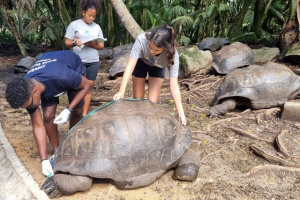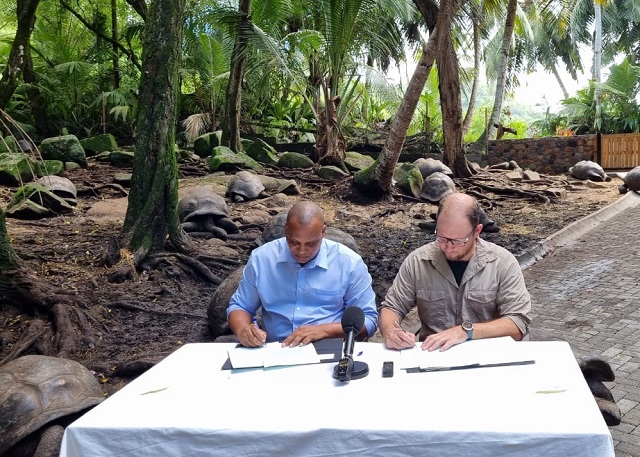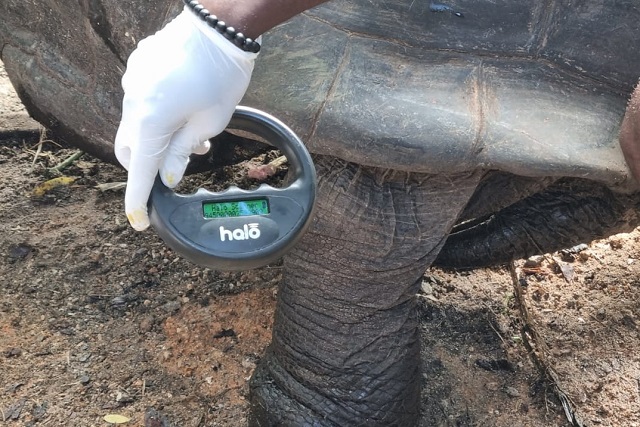Aldabra giant tortoise census: Seychelles and IOTA sign agreement for new survey
Species |Author: Salifa Karapetyan Edited by: Betymie Bonnelame | May 3, 2023, Wednesday @ 09:49| 32412 views
The census was kicked off at the Cap Lazare Nature Reserve. (Seychelles News Agency)
A census has been planned to identify the number of Aldabra giant tortoises in captivity to allow relevant authorities to better understand the reptiles' population on the inner islands of Seychelles. This will allow for better protection and conservation of the species.
The census was initiated through the signing of a memorandum of understanding (MoU) between the Biodiversity Conservation and Management Division of the Environment Department and the Indian Ocean Tortoise Alliance (IOTA) on Friday, April 28.
The census was kicked off at the Cap Lazare Nature Reserve, home to an estimated 65 tortoises and 20 to 30 hatchlings in its nursery.
Signed by the principal secretary for environment, Denis Matatiken, and IOTA's project director, Rich Baxter, the agreement is set to facilitate Aldabra giant tortoise protection, conservation, management, research, and welfare.
 |
| The agreement was signed by PS Matatiken (left) and IOTA's project director, Rich Baxter. (Seychelles News Agency) Photo License: CC-BY |
IOTA is a regional not-for-profit organisation based in Seychelles, primarily focused on researching Aldabra giant tortoises, to understand their ecology and what they do in the wild. It seeks to re-populate tortoises on inner islands and possibly outer islands, as well as to bolster those populations should anything happen to the population on Aldabra.
At the moment Seychelles' population of Aldabra giant tortoises in captivity and the wild is not completely known. Baxter told reporters that on Aldabra there are around 100,000 tortoises in the wild.
Fregate Island, which is home to the second largest population in Seychelles, and the largest population of re-wilded giant tortoises in the world, has about 2,500 to 3,000 tortoises.
"There are other islands with a couple of hundreds here or there, and we would like to see what these numbers are on these other islands. We would like to know what the situation is on the other islands in Seychelles, primarily Mahe, Praslin, and La Digue. For the number that are in institutions like hotels and guesthouses, but also private owners, because it's a big part of the Seychelles culture having giant tortoises as pets and we would like to understand the situation there as well," said Baxter.
 |
| Through the census, which is expected to take a year to complete, tortoises privately owned will be microchipped. (Seychelles News Agency) Photo License: CC-BY |
He said that by knowing the population "we can then try to understand more about how to manage the population."
Through the census, which is expected to take a year to complete, tortoises privately owned will be microchipped. Each microchip has a unique serial number which will be logged along with other details of the chipped tortoise. Matatiken outlined that the microchipping of captive tortoises will be for research purposes and allow for follow-ups.
"Once a tortoise is microchipped, there is also the benefit of locating if it gets lost. Through the microchip, we will be able to identify each tortoise," said Matatiken.
A total of 5,000 microchips, the size of a grain of rice, were donated by Parco Natura Viva, a safari park and zoo in Italy, to the ministry for the census.
The census will also allow the partners to see how people treat their tortoises as pets and whether basic necessities like living conditions and food are properly provided.
Matatiken outlined that "if we identify at any point that the manner in which tortoises are being kept is correct, it will be our responsibility to educate the owner, and together with the alliance, to come up with protocols and basic things that a person can do to ensure the tortoises' wellbeing."
Back
